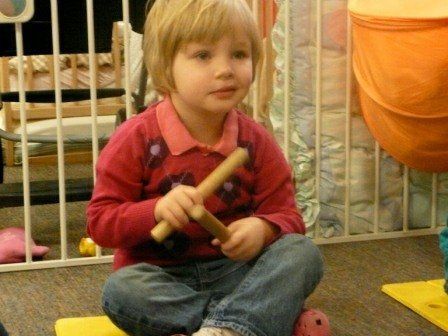What happens

When I am running the music sessions I divide the children up into three age groups where possible.
Babies 0 - 2 year olds.
When working with the babies I am focused on rhythmical songs, which we can bounce, tap, shake to.
I use a mix of percussive instruments, which the babies can easily hold and explore ways of making sounds. When using shakers we will shake them but we might also tap them on our hands, knees, feet to give different sounds and a sense of pulse, with that we are also looking at body part recognition. The babies love repetition and I will use the same tune for different songs so they can anticipate the end of a phrase, when we have the instruments they will often anticipate stop and some of the older babies will hold up their hands to indicate stop with others vocalising.
I use a mix of different styles of music - some traditional nursery rhymes, we dance to different genres of music classical, African, folk. We have action songs which involve wriggling, tapping, bouncing waving up high, we roll our hands, all of which help with their coordination and motor skills. We roll, tip and tilt to the music so that they get a feeling of their bodies and “self”.
Babies love props. During a session we will use Lycra to bounce things on and hide under. Ribbons and scarves and fun to dance with and we have lots of tickle songs with feathers. Above all I use puppets, which will introduce the next activity or give out an instrument. The babies often interact with the puppets and will want to hug.
Musically as well as rhythm and pulse during a session I will have pitch games I might hold the instruments up high and sing in a high voice, down low and sing in a low voice which often has the babies copying the mouth shape for the low voice. We have dynamics with whispery quiet songs and then make lots of noise with bells, which gets the babies very excited and we have legs kicking and smiles showing real enjoyment. Through out the session I am singing even when giving out instruments or packing away, it is all done musically.
When running sessions with parents it is lovely to see the interaction and bonding experience going on between parent and child.
Toddlers 2 - 3 year olds.
At this stage in their lives the toddlers have more control over their movements and their motor skills are finer. This means in the music sessions I am able to move them forward with their beat keeping. We have lots of songs which need a steady pulse either taped out on body parts, clapped or with instruments. When participating in action songs they pick up the simple actions and remember them week to week and are able to perform them, showing their coordination is improving.
Again the instruments I use are percussive, but as well as using them musically we are starting to look at colour and shape recognition and counting them in and out of the box.
At this age most of them are starting to vocalise more freely and will sing parts of the songs. Particularly when singing a rhyming song they will anticipate the ending of songs and phrases, which really helps with their language skills. Musically I am looking at dynamics, beat keeping and pitch though out the session. But also looking at their social skills how they are listening and responding and if their coordination and motor skills are improving. This age group get so excited when they know it is music day and it is such a joy to walk in to a nursery and have the children bursting with excitement and wanting to know what we are singing about today.
Pre School – 3-4 year olds.
At this age children are really interested in the world around them and so I have used their fascination to build a variety of themes. I am also looking at their experiences so far in life so when they play in the garden or at the seaside what have they seen or heard? Their musical learning is then based around these themes.
I have put together a year’s plan, which encompasses the themes, their musical learning and development over the year and also their social development. There are 6 themes one for each term, with the props and instruments relating to the theme.
I start the year with simple beat keeping, although this is an underlying aim across the full year, we will keep the beat with a variety of instruments, with our bodies though movement and action songs and with clapping games. Through out this I also look at dynamics and pitch.
I then adding in tempo, many of the children find slow quiet difficult so we do very big actions and movements with the instruments to try and get the feel for a slow tempo. They all love fast!
Once I feel the children are ready I have some picture rhythm cards, which start to introduce the idea of notation to the children. These cards also help with their reading skills.
The children are encouraged to sing along with familiar and new songs, both as part of the group and at the start of each session as a solo response this is great for their language skills as they call, respond and listen as in a conversation.
At the end of each session we will have a quiet music time, sing a lullaby or say a poem on the theme and then lay down and relax and listen to some quiet music, again I use different genres of music to listen to.
Across all the ages I feel it is really important to have fun, if the children are participating, laughing and engaged with the music and movement they are learning through play.
